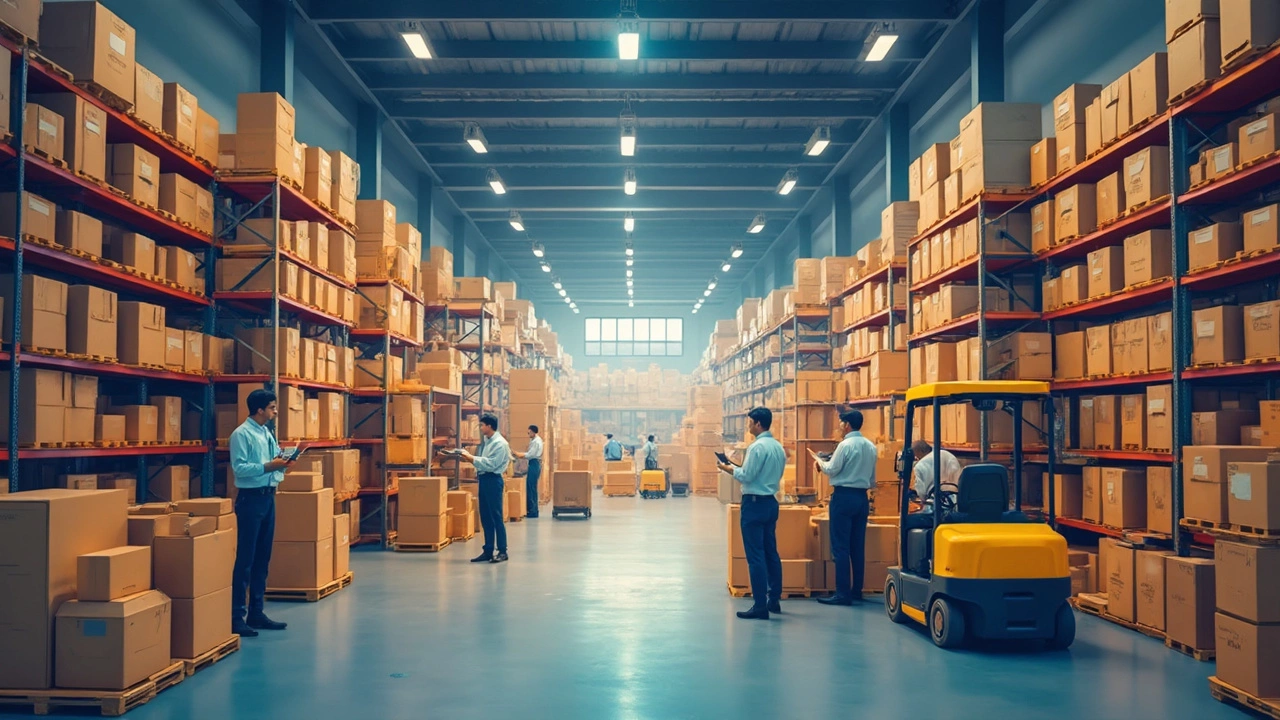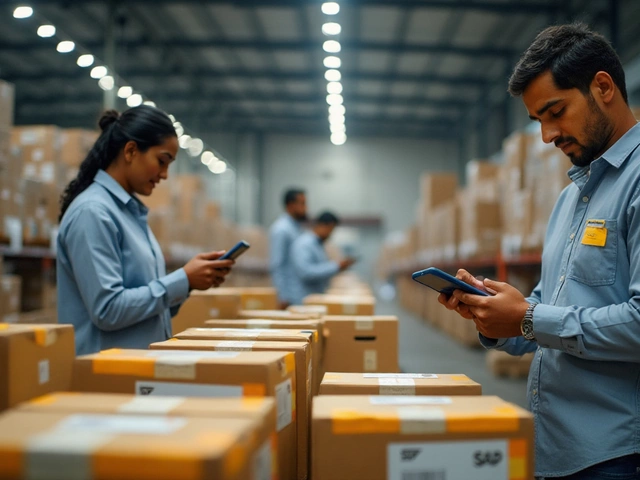If you’re running an online store, logistics can feel like a puzzle nobody gave you all the pieces for. Orders come in fast, but getting those products out the door, tracked, and safely delivered is a whole different challenge. Mess up here, and customers take their business somewhere else—sometimes in just a few clicks.
Clear logistics keep your store’s promises. When you get orders out on time, keep your inventory tight (but not too tight), and handle returns smoothly, people trust you. This isn’t just about moving boxes. It’s about making customers come back again and again. If your deliveries are late or your tracking is a mess, those dreaded one-star reviews start piling up quick.
Here’s the kicker: eCommerce logistics isn’t just picking, packing, and shipping. You need the right tech, good partners, and a plan for when stuff goes wrong. It sounds stressful, but when you break it down, it’s all about making smart choices and staying a step ahead. That means knowing what you really need—and what you don’t—to keep your online business running smooth and your customers happy.
- What Does eCommerce Logistics Really Cover?
- Inventory: Keeping Items Ready Without Overflow
- Shipping Options: Making Delivery Work for Everyone
- Handling Returns Without Losing Money
- Tech Tools Every eCommerce Business Should Use
- Tips to Level Up Your Logistics Game
What Does eCommerce Logistics Really Cover?
If you’ve ever wondered what happens between a click on 'Buy Now' and a package showing up at your front door, this is the stuff that makes or breaks an online shop. ecommerce logistics covers everything needed to get an order to the customer quickly and painlessly. This process starts when someone places an order and ends when that package gets delivered—or returned.
Most folks think logistics is just about shipping, but there’s a lot more going on behind the scenes. Here’s what it usually covers:
- Warehousing: Products need to live somewhere before they ship out. This could be your garage, a rented storage unit, or a giant fulfillment center if you’re big-time. Picking the right spot helps with faster shipping and lower costs.
- Inventory management: Keeping track of what you have and what you’ve sold is a must. An out-of-stock product turns customers away; too much stock just burns cash. According to a 2024 Shopify report, 46% of small online stores have lost sales by not syncing their inventory across channels.
- Order processing: Once an order comes in, someone (or your software) needs to confirm payment, pull the right item, package it up, and get it ready for the carrier. Mistakes here can ruin a customer's week.
- Shipping and delivery: Now it’s in the hands of UPS, FedEx, DHL, or sometimes local couriers. Your choice of carrier and how fast you ship can impact reviews and repeat buys. 40% of shoppers say they ditch their carts if shipping costs are too high or unclear.
- Returns management: Nobody likes dealing with returns, but about 18% of online orders come back, according to the National Retail Federation. Having a clear, easy process makes you look reliable and gives buyers confidence.
Put together, each piece of logistics keeps your store humming. If you skip or mess up a step, things can get ugly. But nail these parts, and you build a reputation for reliability and speed—two things today’s shoppers care about most.
Inventory: Keeping Items Ready Without Overflow
Running an online store means you always worry about what’s on your shelves. Not enough stock? You lose sales. Too much? You spend money on storage and risk products going stale. Smart inventory management keeps you in that sweet spot—ready for demand without getting buried in boxes.
The golden rule: Know exactly what you’ve got at all times. Real-time inventory systems make this way less painful. No more manual counting every week. Tools like Shopify, WooCommerce, and Cin7 sync your inventory across all your channels automatically, so you never accidentally sell what isn’t there.
If you’re still playing it by eye, check out these cold facts:
| Stat | Impact |
|---|---|
| 34% of businesses | have shipped late due to selling products not in stock |
| 46% of shoppers | won’t return after a single out-of-stock experience |
| Inventory carrying costs | average 20-30% of total inventory value each year |
So, how do you prevent overflow and avoid ‘out of stock’ disasters? Here’s what works for most small and mid-size eCommerce shops:
- Use an automated inventory tracking system. Manual spreadsheets are asking for mistakes.
- Set reorder alerts to keep ahead when stock runs low.
- Review your sales data at least monthly. Seasonal spikes? Plan for them. Dead stock? Mark it down or bundle it.
- Go for the ABC method: Keep your high-selling A-items stocked up, monitor B-items, and limit low-sellers (C-items).
If you offer multiple products or sell across a bunch of channels, syncing inventory is huge. Customers expect what they see online to be up to date—no exceptions. The last thing you want is to refund orders because you missed a stock update.
Efficient ecommerce logistics starts with solid inventory habits. Stay on top of stock, and everything else—from shipping costs to happy reviews—gets easier.
Shipping Options: Making Delivery Work for Everyone
Picking the right shipping choices can be the dealbreaker for an online store. People expect fast and reliable delivery, and your options should make life simple—not just for them, but for you. Mess this up, and your store’s reputation can take a nosedive.
The biggest question is: what shipping speeds and carriers will actually work for your business? You’ve got to think about not only what customers want, but also what’s realistic with your products and margins.
- Standard Shipping: It’s the most popular pick. Usually takes 3-7 days in most countries. Most customers are fine with it, especially if it’s free or cheap.
- Express or Next-Day: Needed for customers who want things yesterday. These options cost more, but around 41% of shoppers say they’ll pay extra if they need something fast.
- Pickup Points/Lockers: These are all over cities now. People love them for the privacy and flexibility. Big retailers like Amazon and Walmart push this hard for urban buyers.
- Free Shipping: If you can afford it, offer this at least over a certain order size. Around 73% of people say free shipping is what makes them buy online.
Keep in mind, shipping isn’t just about speed. It’s about clarity. Show real-time tracking, clear delivery windows, and don’t overpromise.
Here’s how shipping options actually affect what people do on your site:
| Shipping Option | Percentage of Customers Who Prefer |
|---|---|
| Standard (3-7 days) | 56% |
| Express (1-2 days) | 21% |
| Free Shipping | 73% |
| Pickup/Locker | 18% |
Your margins matter, so run the numbers before promising every shipping perk on Earth. Use shipping calculators and integrate with carriers like UPS, FedEx, DHL, or regional players to get the best rates.
And don’t forget about international shipping. It opens up more customers, but the paperwork, customs fees, and tracking can get hairy fast. Start close to home before rolling out wider options—unless you want a ton of headaches early on.
If you want your ecommerce logistics to really deliver, set up choices that work for most people and add faster or more flexible extras only when there’s a clear demand. And always be upfront about possible delays—honesty matters more than pretending you can beat Father Time.

Handling Returns Without Losing Money
Returns are the stuff no online store owner wants to deal with, but you can’t ignore them. In eCommerce, around 15% to 30% of all products get sent back—way more than brick-and-mortar shops. That can wreck your profits unless you’ve got a tight plan.
A good return process starts with clear info on your site so customers know what to expect. The smoother you make it, the less stress you’ll have. But if you just accept everything and let products pile up, you’ll leak money fast.
"The best brands use simple, clear return policies to build shopper trust and cut back on abuse," says Shopify’s annual eCommerce Trends report.
The trick is to balance being generous without turning your warehouse into a dumping ground. Here’s how you keep control and even turn returns into an advantage:
- Set time limits on returns—often 30 days works best. Shorter return windows can save money but might upset loyal buyers.
- Don’t offer free returns on everything. Consider charging for high-cost or oversized items, or offering free returns only for first-time buyers.
- Send clear instructions and prepaid labels if possible. It reduces hassle and helps you track what’s coming back.
- Inspect returned products fast, and restock undamaged goods quickly to resell them.
- Track your return reasons. If the same item keeps coming back, maybe it’s got quality issues or your product photo is misleading.
Let’s check out why this matters so much. Here’s what returns do to your bottom line if you’re not careful:
| Return Rate | What Usually Happens | Cost per $1000 Sales |
|---|---|---|
| 5% | Low cost and easy to handle | $50 |
| 15% | Start to feel the strain | $150 |
| 30% | Really cuts into profits | $300 |
If you want to flip the script, some stores offer instant exchanges or store credit—these get people shopping again without you losing out on shipping costs. Others use automation to generate return labels only when needed, stopping abuse from “serial returners.”
At the end of the day, you want a return policy that keeps customers loyal but doesn’t eat your store alive. Your ecommerce logistics plan should be watching every dollar returns touch, just like you do with sales.
Tech Tools Every eCommerce Business Should Use
Trying to run your online shop without the right tech? Forget it. You’ll end up chasing problems instead of fixing them. Today, eCommerce platforms and logistics software work together to cut out the guesswork, help you move faster, and keep customers up to speed.
Here are a few essential tech tools no online seller should skip:
- Inventory management systems (IMS): These keep track of what’s in stock, what’s running low, and when you need to reorder. A great IMS like TradeGecko or Zoho Inventory shows you everything in real time, so you don’t oversell or disappoint customers.
- Order management software: Solutions such as ShipStation or Ordoro put order details, shipping status, and tracking all in one place. They save tons of time and let you fix problems before anyone complains.
- Warehouse management systems (WMS): These boost the speed and accuracy of picking, packing, and shipping. A solid WMS connects with your store and shipping carriers—so mistakes go down and efficiency goes way up.
- Shipping and carrier integration: Apps like Easyship and Shippo compare carrier rates, print labels, and update customers with tracking numbers automatically. You’re not stuck with just one delivery company, and you can pick the cheapest or fastest option for each order.
- Returns management tools: Returnly and Loop Returns make it easy for customers to send stuff back and just as easy for you to process refunds. Happy returns mean shoppers are more likely to come back—even when things aren’t perfect.
Don’t just take my word for it. Jackie Goldstein, VP of Operations at a big logistics provider, says:
“Shops that use real-time tracking and inventory tools see up to 50% less overselling and shipping mistakes. Customers expect instant updates—and the right tech makes that possible.”
Still not convinced? Check out what businesses that use these tools are seeing:
| Tool | Reported Benefit |
|---|---|
| Order Management | Handles up to 35% more orders daily |
| Warehouse Software | Reduces picking errors by 67% |
| Shipping Integrations | Lowers shipping costs up to 20% |
| Returns Management | Cuts return processing time in half |
Bottom line? Plugging the right tech into your ecommerce logistics setup doesn’t just make your life easier—it helps you sell more and keeps your customers stoked.
Tips to Level Up Your Logistics Game
Packing and shipping are just the basics. If you want your store to stand out, it’s all about working smarter, not harder. Here’s how you can up your logistics game and keep those five-star reviews rolling in.
- ecommerce logistics runs smoother with automation. Use software to handle order picking, tracking, and inventory updates. Around 65% of top-performing online stores rely on warehouse management systems or plugins. Manually juggling orders? That’s asking for mistakes—and angry customers.
- Work with more than one shipping partner. Sticking to just one carrier is risky. If they have a meltdown, so does your delivery schedule. Compare rates, speed, and service. Backup options keep you covered during holiday spikes or random delays.
- Use real-time inventory tracking. Inventory errors are one of the top reasons online businesses lose money. Set alerts for low stock, and try syncing inventory levels across all your sales channels. If you sell on Amazon, eBay, and your own site, everything needs to talk to each other.
- Make returns easy but not expensive. Prepaid return labels can boost trust with shoppers. Around 92% of customers say they’ll buy again if returns are hassle-free. Offer clear rules and try automating refunds for common cases.
- Test your packaging. Durable boxes are worth it—crushed or broken goods cost you double with replacements and refunds. The unboxing moment means a lot now; consider including instructions or loyalty perks inside.
- Keep customers in the loop. Automated tracking updates cut down on "Where’s my order?" emails. People get antsy if they don’t know what’s happening. Some platforms even let you text updates or send quick progress emails at every step.
Here’s a quick breakdown of stuff that can make a big difference when you’re stepping up your logistics:
| Tip | Quick Stat or Fact |
|---|---|
| Inventory Automation | Up to 30% boost in order accuracy |
| Multiple Shipping Carriers | Improves delivery speed by up to 25% in peak seasons |
| Easy Returns | 92% of buyers repeat when returns are headache-free |
| Real-Time Tracking | Reduces support tickets by as much as 40% |
Last tip: keep an eye on your data. If something’s always out of stock or taking forever to ship, don’t just cross your fingers—look at the numbers and tackle issues head-on. Your customers (and your sanity) will thank you.





